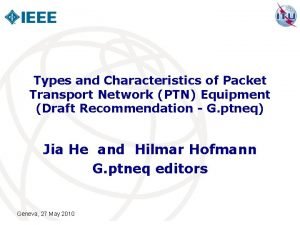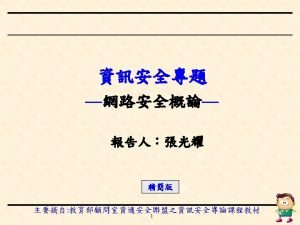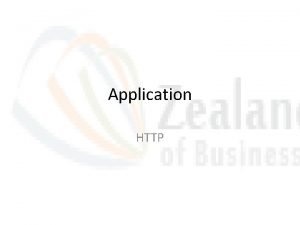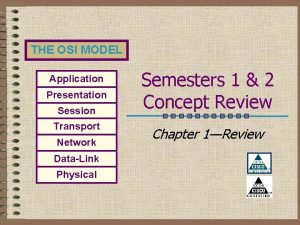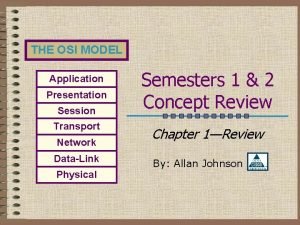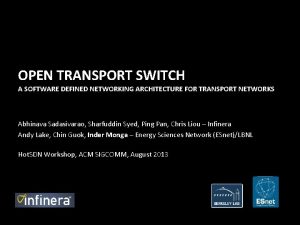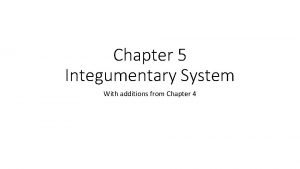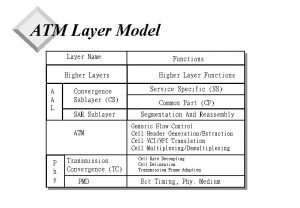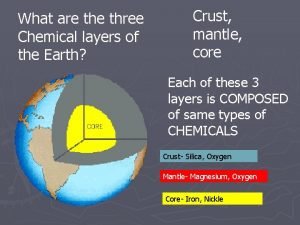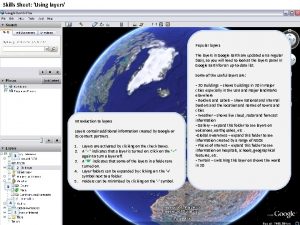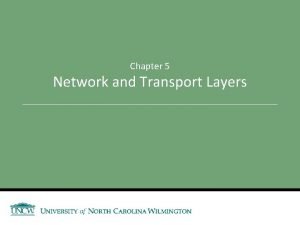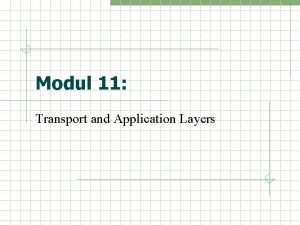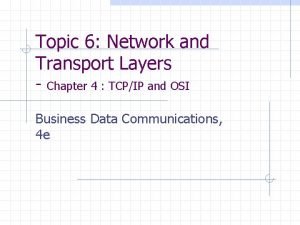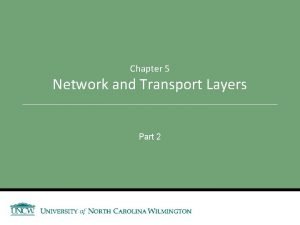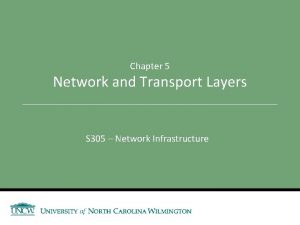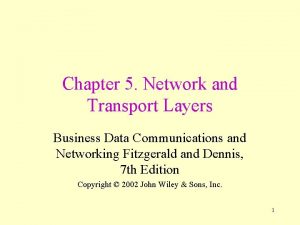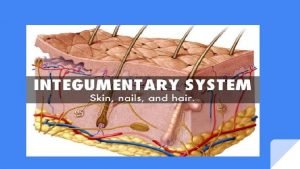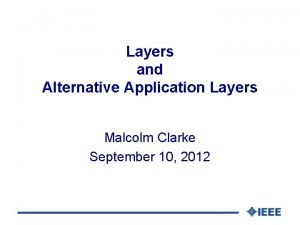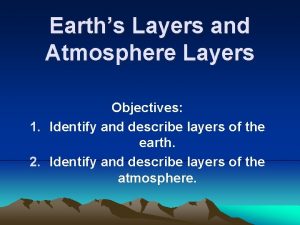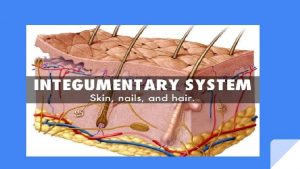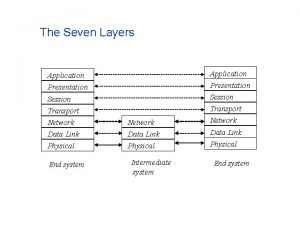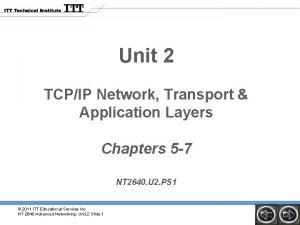Chapter 5 Network and Transport Layers Chapter 5


























- Slides: 26

Chapter 5 Network and Transport Layers

Chapter 5 Outline Transport & Network Layer Protocols § TCP/IP Transport Layer Functions § Linking to the Application Layer § Segmenting § Session management Addressing § Assigning addresses and address resolution Routing § Types of routing, routing protocols, and multicasting TCP/IP Examples Copyright 2010 John Wiley & Sons, Inc

Network Layer Computer 1 Computer 2

5. 4 Routing Process of identifying what path to have a packet take through a network from sender to receiver Routing Tables § Used to make routing decisions § Shows which path to send packets on given destination § Kept by computers making routing decisions Dest. Next B B C B D D E D F D G B to reach a Routers § Special purpose devices used to handle routing decisions on the Internet § Maintain their own routing tables 5 -4

5. 4. 1 Simple Routing Example Possible paths from A to G: • ABCG • ABEFCG • ADEBCG A Routing Table for A Dest. Next B C D E F G Each node has its own routing table 5 -5

5. 4. 1 Routing Example – LAN with Routers 5 -6

5. 4 Routing 5 -7

5. 5. 1 TCP/IP Network Example 5 -8

5. 4. 1 Types of Routing Centralized routing § § Decentralized routing § § § 5 -9

5. 4. 2 Routing Protocols – how tables are set up Static routing: § Uses fixed routing tables developed by network managers • Each node has its own routing table • Changes when computers added or removed Dynamic routing or Adaptive routing: § Uses routing tables at each node that are updated dynamically § Based on routing condition information exchanged between routing devices § Types 5 - 10

5. 4. 2 Dynamic Routing Algorithms Distance Vector § Uses the least number of hops to decide how to route a packet Link State § Uses a variety of information types to decide how to route a packet (more sophisticated) • e. g. , number of hops, congestion, speed of circuit § Links state info exchanged periodically by each node to keep every node in the network up to date § Provides more reliable, up to date paths to destinations 5 - 11

5. 4. 2. 1 Routing Information Protocol (RIP) A dynamic distance vector interior routing protocol Operations: § Manager builds a routing table by using RIP § Routing tables broadcast periodically (every minute or so) by all nodes § When a new node added, RIP counts number of hops between computers and updates routing tables 5 - 12

5. 4. 2. 1 Open Shortest Path First (OSPF) A dynamic link state interior routing protocol Became more popular on Internet § More reliable paths § Less burdensome to the network 5 - 13

5. 5. 1 Sending Messages using TCP/IP Required Network layer addressing information 1. 2. 3. 4. Address information is obtained from a configuration file or provided by a DHCP server What additional information is needed for servers? 5 - 14

5. 5. 1 TCP/IP Configuration Information 5 - 15

5. 5. 1 Subnet Masks Tells the computer what part of an Internet Protocol address to be used to determine whether the destination is on the same subnet or on a different subnet Example § Subnet: 149. 61. 10. x § Subnet mask: 255. 000 Example § Subnets: 149. 61. 10. 1 -128, § Subnet mask 255. 128 5 - 16

5. 5. 1 TCP/IP Network Example 5 - 17

5. 5. 1 Moving Messages - TCP/IP and Layers How layers are handled in a LAN: • Host Computers • Packets move through all layers § Gateways, Routers • Packet moves from Physical layer to Data Link Layer through the network Layer At each stop along the way (e. g. from router to router): § Ethernet packets is removed and a new one is created for the next node § IP and above packets never change in transit (created by the original sender and destroyed by the final receiver) 5 - 18

5. 5. 1 Message Moving Through Layers 5 - 19

5. 5. 2 Known IP Address Transmit from A => E (A knows E’s IP Address) How many Hops will it take? PATH IP Source IP Destination Ethernet Source Ethernet Destination 5 - 20

5. 5. 3 Unknown IP Address Transmit from A => E (A doesn’t know E’s IP address) How do we do this? PATH IP Source IP Destination Ethernet Source Ethernet Destination DNS Request DNS Response 5 - 21

5. 5. 4 Unknown Data Link Address Transmit from A => E (doesn’t know E’s Ethernet address) • An ARP request from D will occur once the message sent by A is received by D. PATH IP Source IP Destination Ethernet Source Ethernet Destination 5 - 22

5. 5. 2 Known IP Address and Ethernet Address Transmit from B => F (B knows F’s IP Address) PATH IP Source IP Destination Ethernet Source Ethernet Destination 5 - 23

5. 5. 3 Unknown IP Address Transmit from B => F (B doesn’t know F’s IP address) PATH IP Source IP Destination Ethernet Source Ethernet Destination 5 - 24

5. 5. 4 Unknown Ethernet Address Transmit from B => F (doesn’t know F’s Ethernet address) PATH IP Source IP Destination Ethernet Source Ethernet Destination 5 - 25

Implications for Management Most organizations moving toward a single standard based on TCP/IP § Decreased cost of buying and maintaining network equipment § Decreased cost of training networking staff Telephone companies with non-TCP/IP networks are also moving toward TCP/IP § Significant financial implications for telcos § Significant financial implications for networking equipment manufacturers 5 - 26
 Primary and secondary transport
Primary and secondary transport Membrane structures that function in active transport
Membrane structures that function in active transport Passive trnasport
Passive trnasport Now answer the following questions
Now answer the following questions Active transport vs passive transport venn diagram
Active transport vs passive transport venn diagram Unlike passive transport active transport requires
Unlike passive transport active transport requires Primary active transport vs secondary active transport
Primary active transport vs secondary active transport Bioflix activity membrane transport active transport
Bioflix activity membrane transport active transport Isotonic in biology
Isotonic in biology Ptn packet transport network
Ptn packet transport network Network osi
Network osi Application transport network link physical
Application transport network link physical Application presentation session
Application presentation session Application presentation session transport network
Application presentation session transport network Open transport network
Open transport network Virtual circuit vs datagram
Virtual circuit vs datagram Features of peer to peer network and client server network
Features of peer to peer network and client server network Network centric computing and network centric content
Network centric computing and network centric content Network topologies
Network topologies Network systems design using network processors
Network systems design using network processors Disadvantages of circuit switching
Disadvantages of circuit switching Vodafone opco
Vodafone opco Chegg
Chegg Merocrine gland
Merocrine gland Name the atm layers and their functions
Name the atm layers and their functions Compositional layers of the earth
Compositional layers of the earth 2008
2008









